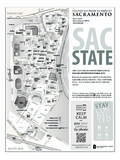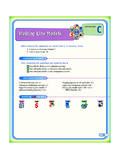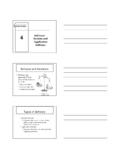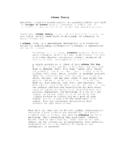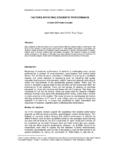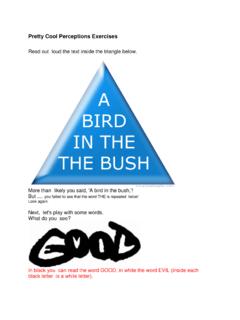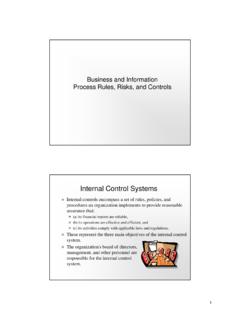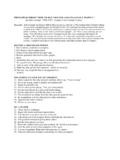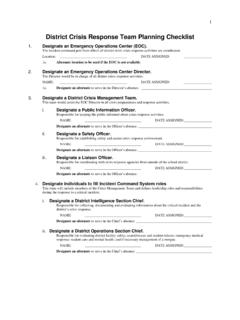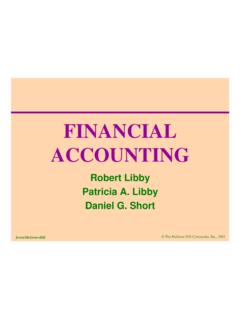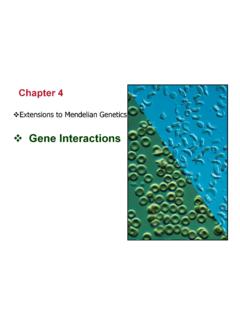Transcription of EXERCISE 7 - LINKAGE, CROSSING-OVER, & GENE …
1 1 EXERCISE 7 - LINKAGE, crossing - over , & gene MAPPINGIN DROSOPHILALINKAGE AND crossing -OVERA ccording to Mendel s principle of independent assortment, a dihybrid cross withunlinked markers ought to produce a 1:1:1:1 ratio. If a significant deviation from this ratiooccurs, it may be evidence that for linkage, that is, that the loci are located close to each other onthe same chromosome meiosis, a pair of synapsed chromosomes is made up of four chromatids, called atetrad. The phenomenon of a cross - over occurs when homologous chromatids in the tetrad(one from each of the two parents) exchange segments of varying length during prophase. Thepoint of crossover is known as a chiasma (pl. chiasmata). A tetrad typically has at least onechiasma along its length. Generally, the longer the chromosome, the greater the number ofchiasmata. There are two theories on the physical nature of the process. The classical theoryproposes that cross - over and formation of the chiasma occur first, followed by breakage andreunion with the reciprocal homologues.
2 According to this theory, chiasma formation need not beaccompanied by chromosome breakage. Alternatively, according to the chiasmatype theory,breakage occurs first, and the broken strands then reunite. Chiasmata are thus evidence, but notthe causes, of a cross -overs. Recent molecular evidence favours the latter theory, although neitheris a completely satisfactory explanation of all of the produced by a dihybrid heterozygous individual with linked lociConditionMeiotic tetradGametesCombinationNo crossoverParentalPPPS ingle crossover:markers in cisa+b+//ab PRecombinantRecombinant P2 Single crossover:markers in transa+b//ab+PRecombinantRecombinantPIn dihybrid crosses, an arrangement in which the wild-type alleles of both loci arecontributed by one parent is referred to as a cis configuration; the alternative arrangement iscalled a trans configuration. A gamete that shows the same configuration as the parent isreferred to as a parental type; where the configuration is altered, the gamete is referred to as arecombinant type.
3 Cis and trans configurations are altered by between loci is indicated when the recombinant phenotypes occur less frequentlythan the parental types. The frequency of crossing over (% recombination) between two loci isdirectly related to the physical distance between those two loci. Percent recombination in a testcross equals map distance (1 map unit = 1 % recombination).eg. P1 a+b//a+bxab+//ab+F1a+b//ab+xab//ab (test cross )F2:a+b//ab , ab+//ab 90% - parental combinations a+b+//ab, ab//ab 10% - recombinant 10% recombinant indicates that loci a and b are 10 map units apart. gene Map a b 10 m. , if it is known that loci b and c are 16 map units apart, then the expectedproportions of parental and recombinant phenotypes in a test cross can be +c//b+cxbc+//bc+F1b+c//bc+ xbc//bc (test cross )3In a test cross 8 %b+c+8%bc42%b+c42%bc+100 % bcIn a F1 x F1 cross 8%b+c+8%bc42%b+c42%bc+50% b+c50% bc+Multiple CrossoversAnalysis of the genetic behaviour of three or more linked loci may show evidence ofmultiple cross -overs.
4 When three loci are involved, there will be two parental types, fourrecombinant classes with single cross -overs and two recombinant types showing cross -oversbetween all three loci ( = double cross - over ). The two parental types will be most abundant, thefour single cross - over (SCO) recombinants will be next while the two double cross - over (DCO) recombinants will be least cross - over situation results in two parental gametes and two recombinant gametes. The maximum recombination between any two loci is 50% (since of the gametes are parentaltype).4 Gametes produced by trihybrid heterozygous individual. a+ b+ c+ / a b cMeiotic tetradGametesCombinationSingleCrossover( a-b)PRRPS ingleCrossover(b-c) PRR PDoubleCrossoverPRR P5 MAKING A gene MAPThe recombination frequency is constant for any pair of linked loci and represents the"genetic" distance between them. Each 1 is the distance that will generate 1% is possible to develop a gene map, showing the order of the loci and the distancebetween them by observing the number of offspring showing recombinant 1: A standard problem in genetics is to determine the order of three loci known to belinked on one pair of the autosomes.
5 Solution of the problem requires (1) a determination of therelative order of loci, and (2) the map distances between cross is made between homozygous wild-type female Drosophila (a+a+b+b+ c+c+) andtriple-mutant males (aa bb cc) (the order here is arbitrary). The F1 (a+a b+b c+c) females are testcrossed back to the triple-mutant males and the F2 phenotypic ratios are as follows: a+ b c 18 a b+ c 112 a b c 308 a+ b+ c 66 a b c+ 59 a+ b+ c+ 321 a+ b c+ 102 a b+ c+ 15 gene order can be determined by examination of the relative frequencies of the F2phenotypes. linked loci tend to stay together, the non-crossover (NCO) or parentalphenotypes should be most frequent (and equal in number). In this case a+b+c+ (321) and a b c (308) simultaneous crossovers between the outside and middle loci areunlikely, the double-crossover (DCO) genotypes should be the least frequent. Weobserve a+ b c (18) and a b+c+ (15) , to determined the physical order of loci, compare the parental and double-crossover phenotypes.
6 The marker that appears to switch places is in themiddle [technically, this marker is said to be out of phase ]. Here, the a+b+c+NCO and a b+c+ DCO phenotypes indicate that the a locus falls between the b and6c loci. The correct order of the loci is b a c . [Note that this order is equivalent toc a b , and that the order of the outside markers is arbitrary]. coupling phase of the trihybrid F1 is b+a+c+ / b a remaining two pairs of phenotypes correspond to single-crossovers (SCO) events inthe region between either b and a, or between a and +a c (112) and b a+c+ (102) phenotypes indicate crossovers between b & a. +a+c (66) and b a c+ (59) phenotypes indicate crossovers between c & percent recombination between two markers indicates the map distance betweenthem: 1% recombination = 1 map unit ( ). To determine the map distance between apair of loci, count the number of SCO and DCO events, and use the following formula[the most common error is to neglect the DCO classes].
7 Map distance = % recombination= (# in SCO phenotypes + # in DCO phenotypes x 100)(total # progeny)(b a) Map distance = 112 + 102 + 18 + 15 x 100 = = 1000(a c) Map distance = 66 + 59 + 18 + 15 x 100 = = 1000(b c) Map distance = + = can now draw a map segment showing order and distances among loci. Again, notethat the orders b-a-c and c-a-b are equivalent and that the left/right the orientation of thismap is arbitrary]b a c | | || |USING A gene MAPThe gene map can be used as a table of probabilities to predict the expected amount of7recombination between certain a test cross the male contributes only recessive alleles. Recombination occurs in theformation of the female gametes. Therefore whatever alleles present in the female gamete will beexpressed in the phenotype of the is a certain probability that a cross - over will form between a and b loci (= mapdistance between a and b) and another independent probability that a cross - over will occurbetween b and c loci (= map distance between b and c).
8 The probability of a double cross - over isthe product of these two independent 2: Given the map segment cn vg sm | | | In a test cross of cn+vg+sm+ // cn vg smExpected DCO = (% recomb. cn-vg) (% recomb. vg-sm) = x = we expect to find of the female gametes to be the results of cn+vg sm+ cn vg+ smExpected SCO (cn-vg)From the gene map of the gametes would be expected to have crossovers betweencn and vg, however this includes the of double crossovers. Therefore = ofthe female gametes should have single crossovers: cn vg+ sm+ &. cn+ vg smExpected SCO (vg-sm)From the gene map of the gametes would be expected to have crossovers betweenvg and sm, this includes the of double crossovers. Therefore of the female gametesshould have single crossovers cn+vg+sm & cn vg sm+8 Total crossovers = + + = parental gametes ( of each).
9 Gametes gametes = 100 % cn vg % cn+vg+sm+ % cn vg % cn vg sm+ % cn+vg+sm % cn vg+sm+ % cn+ vg sm cn vg+ sm % cn+ vg sm+These percentages can then be used to determine an expected : cn vg sm: cn vg : sm : cn : vg sm : vg : cn : : : : : : : : : : : : : 1 : 1 INTERFERENCE and COINCIDENCE crossing over does not occur uniformly along a chromosome. For example, fewercrossovers occur in the area around the centromere than in other areas of the chromosome(making the loci appear closer together than they actually are). Also, the formation of onechiasma typically makes it less likely that a second chiasma will form in the immediate vicinityof the first. This seems to be due may be due to the inability of the chromatids to bend backupon themselves within a certain minimum lack of independence is called interference and results in the observation of fewerdouble crossover types than would be expected according to true map varies in different sections of the chromosome and is measured by theCoefficient of Coincidence ( ) which is the ratio of observed to expected double = (observed DCO) / (expected DCO)Interference = 1 - 9To calculate expected DCO, actual distances from gene map should be used when available.
10 If = 0 then interference is complete and no double crossovers are observed. In general,double-crossovers do not occur between loci less than 10 values between 0 and 1 indicate partial interference. Generally interference decreases as thedistance between the loci = 1 then there is no interference and all the expected double crossovers are loci more than 45 apart there is little or no interference. In some cases there may be anexcess of double crossovers, negative EXAMPLE 1 = (observed DCO) / (expected DCO) = (33) / ( )( )(1000) = 33 / 39 = Seeing of the double crossovers expected. Interference = 1 - = 1 - .846 = = coefficient of coincidence can also be used to modify the number of doublecrossovers predicted from a EXAMPLE 2: In the region cn-sm double crossover type were expected. However if is known to be 70% for this region, then the number of expected double crossovers ismodified (.)
